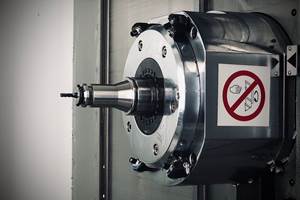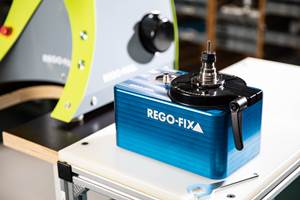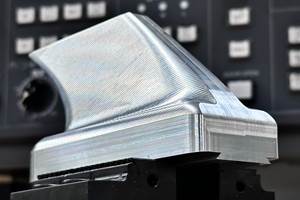PCD Tools Get Tough
Contrary to their reputation as tools reserved strictly for finish machining of non-ferrous metals, some polycrystalline diamond (PCD) cutting tools now possess the durability to handle a much wider range of applications.
Share





Contrary to their reputation as tools reserved strictly for finish machining of non-ferrous metals, some polycrystalline diamond (PCD) cutting tools now possess the durability to handle a much wider range of applications. As the utilization of aluminum-based parts continues to grow—particularly in automotive manufacturing—the performance of PCD tooling has become a more significant issue. In turn, this has produced strong, recent growth in the worldwide market for PCD tools.
Although cutting tools represent only a small percentage of the total cost to manufacture a specific part, the costs to interrupt production for frequent tool changes are substantial. Conventional PCD tools cannot withstand the wide variations in cutting force that are typical of rough-machining operations. Under these conditions, cutting edges chip readily, and tool consumption is unacceptably high. Chipping of the cutting edge commonly occurs during the initial stage of an interrupted machining process. As these chips accumulate, surface smoothness of the workpiece degrades and burring increases. For these reasons, cemented carbide tools are commonly used for milling and rough cutting of aluminum alloys.
The composition of conventional PCD tools derives from the sintering process by which they are manufactured. Because this process yields unbalanced distributions of diamond particles and a ferrous metal catalyst (primarily cobalt), an inverse relationship exists between wear resistance and strength in the tool. Coarse grades of PCD tools (containing larger diamond particles) are the most wear-resistant types, but they also have the least strength and toughness. Conversely, fine grades of PCD tools are very tough, but wear resistance is poor. Because of this performance trade-off, medium grades of conventional PCD tools are typically used to machine aluminum parts. But these tools can only provide median levels of toughness and wear-resistance.
To address these limitations, Sumitomo Electric Carbide, Inc. (Mt. Prospect, Illinois) has developed the Sumidia DA2200 line of high-strength PCD cutting tools. The proprietary manufacturing process for these tools produces uniform distribution of extremely fine diamond particles. This gives the tools a combination of substantial wear resistance and toughness (defined as “transverse rupture strength”). The result is a cutting edge with sufficient durability to handle rough and interrupted machining of various aluminum alloys and other non-ferrous metals.
Sumitomo has tested its new line of PCD tools under a variety of machining conditions. In milling and rough-cutting tests using an aluminum alloy workpiece, the performance of these tools is equivalent to cemented carbide tools. In continuous cutting tests, the DA2200 tools demonstrate wear resistance equivalent to conventional, medium-grade PCD tools.
Based on four typical machining applications for aluminum alloy parts, Sumitomo compared the performance of its improved PCD tools to conventional PCD and cemented carbide tools. In the facemilling of automotive cylinder heads, as well as endmilling of base plates for hard disk drives, the DA2200 tools demonstrated life spans up to three times longer than conventional PCD tools. When rough cutting a die-cast aluminum transmission component, the tools lasted approximately 20 times longer than cemented carbide. Additionally, when turning aluminum alloy wheels for autos, the tools delivered up to 17 times the life of conventional PCD tools. One of the nation’s largest automotive wheel manufacturers recently tested the tools independently and achieved 12-14 times the life of its existing PCD tools.
The improved inserts are available in a wide range of geometries and edge preparations for various applications. Inserts that incorporate WF-type edge preparation, for example, can produce mirror-like surface finishes. The tools are also available with reinforced K- and H-type edge preparations to bolster cutting edge strength during severely interrupted machining. These tools are suitable for machining aluminum alloys incorporating up to 18 percent silicon content.
Related Content
How to Troubleshoot Issues With Tool Life
Diagnosing when a tool is failing is important because it sets an expectation and a benchmark for improvements. Finding out why gives us a clue for how to fix it.
Read MoreFive Common Mistakes Shops Make with ER Collets (And How to Prevent Them)
Collets play a crucial role in the machining process, so proper tool assembly and maintenance is important. Here are five potential pitfalls to avoid when using ER collets.
Read MoreBriquetting Manufacturer Tools Up for Faster Turnaround Times
To cut out laborious manual processes like hand-grinding, this briquette manufacturer revamped its machining and cutting tool arsenal for faster production.
Read MoreCustom Workholding Principles to Live By
Workholding solutions can take on infinite forms and all would be correct to some degree. Follow these tips to help optimize custom workholding solutions.
Read MoreRead Next
AMRs Are Moving Into Manufacturing: 4 Considerations for Implementation
AMRs can provide a flexible, easy-to-use automation platform so long as manufacturers choose a suitable task and prepare their facilities.
Read MoreMachine Shop MBA
Making Chips and Modern Machine Shop are teaming up for a new podcast series called Machine Shop MBA—designed to help manufacturers measure their success against the industry’s best. Through the lens of the Top Shops benchmarking program, the series explores the KPIs that set high-performing shops apart, from machine utilization and first-pass yield to employee engagement and revenue per employee.
Read More





















